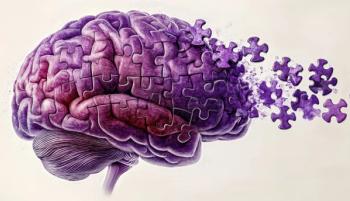
- Psychiatric Times Vol 35, Issue 10
- Volume 35
- Issue 10
Memory’s Last Breath: Field Notes on My Dementia
Gerda Saunders, an emerita professor who was diagnosed with vascular dementia at age 60, explores the meaning of progressive cognitive impairment in relationships and life.
By Gerda Saunders
Reviewed by Burns Woodward, MD
Gerda Saunders, an emerita professor of gender studies, was diagnosed with vascular dementia at age 60. Her MRI showed multiple frontal lobe lesions. She describes her blunders-mismatched clothing, exiting stores without paying, damaging her car in a parking lot, rescue calls to her husband-with good-natured empathy. The story is carried by memories of her childhood in apartheid South Africa, university education in science, courtship and marriage, the family’s emigration to Salt Lake City, and her careers as mother, professor, and grandmother. With this she interweaves medical, psychological, and legal information about dementia. Most compelling are her fearless explorations of dementia in intimate relationships, and of suicide and assisted death for people with end-stage dementia.
The discrepancy between “the indignities accumulating in my daily activities” and her preserved writing skills led Saunders to wonder if she was “faking” dementia. Studying cognitive science, she learned of patients with more severe functional impairments who retained high-level skills they learned long ago. Her conclusion: “persons having spent a lifetime mastering particular knowledge structures and intellectual skills may retain access to this expertise even after becoming utterly dependent in daily activities . . . But in truth, writing is getting slower and harder.”
Slower and harder, but compelling. Her account of cortical functions is more cogent than most neuroscience writing:
The parietal lobe is the site where visual auditory, and haptic, or touch-based, information combine to make sense of the world. The left parietal lobe is the area where letters come together to form words and where words are put together in thoughts. The right lobe enables understanding of the spatial nature of the world, including the ability to recognize faces and shapes, be aware of body states and deficiencies, and know directions.
Two central chapters explore the implications of dementia for intimate relationships. She draws on her own marriage; John Bayley’s memoir of the dementia that killed his wife, the writer Iris Murdoch; a neighbor couple who had to be separated when the husband’s aggression became unmanageable; and a legislator who was tried and acquitted for sexual abuse of his wife, the claim being that she was too impaired to consent.
Dementia is an arduous subject, but Saunders’s understated style and creative juxtapositions hold and engage the reader. A feminist analysis of her relationship to fashion quickly morphs into struggles to remember what outfits go together, remedied by a photo album of successful combinations, followed by a trip to Nordstrom to resolve a funky mood but getting trapped in a locked stairwell. This ends, “I’m afraid my projects of writing down and/or photographing my outfits have, for the moment, come to an end. It takes me so long to write and just take care of myself that I have not been able to keep up my mnemonic system.”
No American state allows assisted suicide for people with dementia (or any other mental disorder). In a final chapter which rivals those on relationships for its unflinching courage, Saunders explores end-of-life issues around dementia. She does not want a painful and burdensome existence when her mind is gone, but more important is protecting her family from legal risk for hastening her death. She settles on voluntary stopping eating and drinking as a possible method. Here are a few of the “flags” she has provided to her relatives and health care agent about whether her quality of life is “dwindling below the level of acceptability”:
• Do I appear and act happy for more hours per day than I appear and act unhappy?
• Do I enjoy being in my garden (or that of the care center) watching the plants, birds, and insects? Can I physically get there without needing a team of people?
• Am I physically approachable without getting myself into a state of fear or anger; that is, is it still a pleasure for me to cuddle with a friend or child or grandchild?
Saunders includes more childhood memories than needed to understand her dementia-one senses an impulse to “get it all down.” But reviewing a life while one is still able can be psychologically important for the individual and family. I would have been grateful for an index, but this is no reference tome. It is a book to be read and experienced.
Disclosures:
Dr Woodward is a psychiatrist in private practice in Waban, MA.
Articles in this issue
about 7 years ago
ADHD: A 24-Hour Disorderabout 7 years ago
ADHD, Bipolar Disorder, or Borderline Personality Disorderabout 7 years ago
ADHD Neuroimaging: What’s New?about 7 years ago
Digital Mental Health for Youth: New Evidence but Still Much Unknownabout 7 years ago
Prescribing Substances of Abuse in Psychiatric Careabout 7 years ago
Three New Studies in Major Depressionabout 7 years ago
Psychocardiology, Part 2: Fixing the Broken Heartabout 7 years ago
Calling in the Scriptabout 7 years ago
Big Data for DepressionNewsletter
Receive trusted psychiatric news, expert analysis, and clinical insights — subscribe today to support your practice and your patients.











